
This portal is to open public enhancement requests against products and services offered by the IBM Data & AI organization. To view all of your ideas submitted to IBM, create and manage groups of Ideas, or create an idea explicitly set to be either visible by all (public) or visible only to you and IBM (private), use the IBM Unified Ideas Portal (https://ideas.ibm.com).
Shape the future of IBM!
We invite you to shape the future of IBM, including product roadmaps, by submitting ideas that matter to you the most. Here's how it works:
Search existing ideas
Start by searching and reviewing ideas and requests to enhance a product or service. Take a look at ideas others have posted, and add a comment, vote, or subscribe to updates on them if they matter to you. If you can't find what you are looking for,
Post your ideas
Post ideas and requests to enhance a product or service. Take a look at ideas others have posted and upvote them if they matter to you,
Post an idea
Upvote ideas that matter most to you
Get feedback from the IBM team to refine your idea
Specific links you will want to bookmark for future use
Welcome to the IBM Ideas Portal (https://www.ibm.com/ideas) - Use this site to find out additional information and details about the IBM Ideas process and statuses.
IBM Unified Ideas Portal (https://ideas.ibm.com) - Use this site to view all of your ideas, create new ideas for any IBM product, or search for ideas across all of IBM.
ideasibm@us.ibm.com - Use this email to suggest enhancements to the Ideas process or request help from IBM for submitting your Ideas.
IBM Employees should enter Ideas at https://ideas.ibm.com
The JDBC driver can be used for connecting your data analysis applications to Data Virtuality Server. Please download compatible version from the table below.
Below you find the different JDBC drivers for the different versions of Data Virtuality Server.
The ODBC driver is meant for connecting your data analysis applications to Data Virtuality Server. Please download it and follow the steps below.
For Windows users: To install the ODBC driver on Windows, download the driver, double-click the installer file and follow the wizard. The installer does not set up a Data Source Name (DSN) automatically. For creating one please consult the Administration Guide, Chapter Installation/Installing Data Virtuality ODBC (Windows).For Linux users: Please consult the Administration Guide – Chapter Installation/Installing Data Virtuality ODBC (Linux).